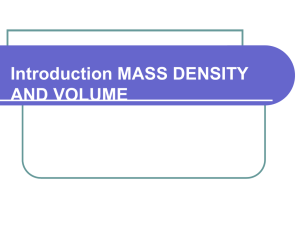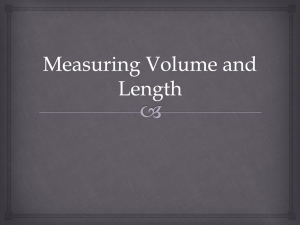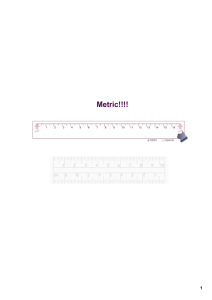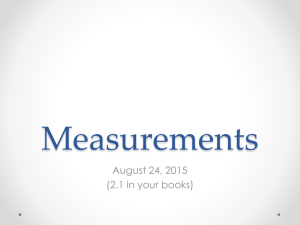Introduction to the Metric System
advertisement
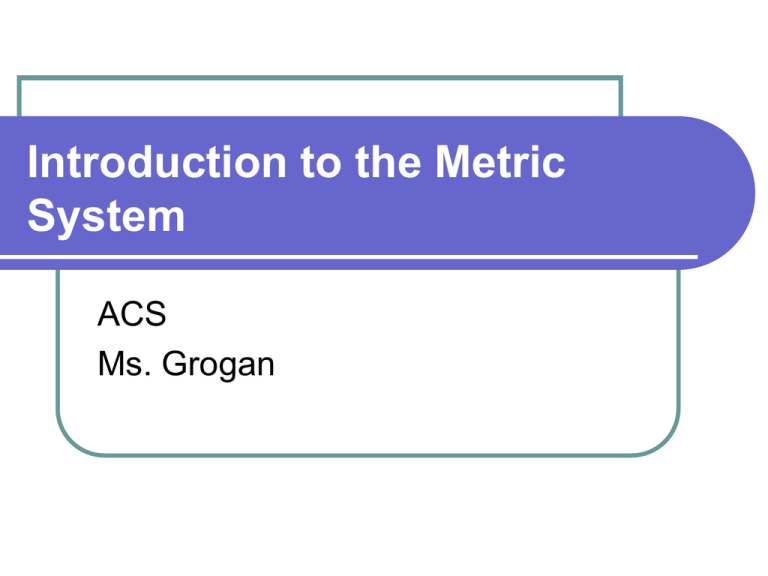
Introduction to the Metric System ACS Ms. Grogan History Created during French Revolution in 1790 French King overthrown National Assembly of France sets up new government French Academy of Science told to design new system of weights and measures Lavaiosie appointed to head committee History Called Systeme International d’Unitès, or SI - International System of Units Revised periodically by International Bureau of Weight and Measures Customary Units of Measurement The English System a collection of functionally unrelated units Difficult to convert from one unit to another Ex. 1 ft = 12 inches = 0.33 yard = 1/5280 miles Customary Units length - inch, foot, yard, mile weight/mass - ounce, pound volume - teaspoon, cup, quart, gallon temperature - degrees Fahrenheit time - minutes, hours Advantages of Using the Metric System Universal - used everywhere by all scientists to communicate by all industrialized nations except United States U.S. loses billions of dollars in trade Advantages of Using the Metric System Simple to use A few base units make up all measurements length - meter mass - grams volume - liters temperature – degrees Celsius time - seconds Advantages of Using the Metric System There is only one unit of measurement for each type of quantity To simplify things, very small and very large numbers are expressed as multiples of the base unit. Prefixes are used to represent how much smaller or larger the quantity is compared to the base unit. Easy to convert from one unit to another shift decimal point right shift decimal point left Advantages of Using the Metric System Same set of prefixes for all units Greek - multiples of the base Latin - fractions of the base kilo - 1000 × the base hecto - 100 × the base deka - 10 × the base deci - tenths of the base centi - hundredths of the base milli - thousandths of the base Mnemonic: “Kids Have Dropped Over Dead Converting Metrics.” Metric Prefixes Units of Length Length - the distance between two points standard unit is meter (m) long distances are measured in km Measured using a meter stick or ruler Prefixes and Units of Length centimeter - cm millimeter - mm 1 m = 100 cm 1 cm = 1/100th m 1 m = 1000 mm 1 mm = 1/1000th m 10 mm = 1 cm measures very small lengths kilometer - km 1 km = 1000 m 1 m = 1/1000th km measures long distances Measuring Mass Mass - the quantity of matter in an object standard unit is gram (g) Measured using a digital scale or triple beam balance Measuring Volume and Capacity Volume - the amount of space occupied by an object standard unit is liter (L) 1 L = 1000 ml = 1000 cm3 = 1 dm3 Measured using a graduated cylinder Capacity - a measure of the volume inside a container Prefixes and Units of Volume Liter - L milliliter - mL 1 L = 1000 milliliters 1 L = 1000 cubic centimeters = 1000 cm3 measures small volumes 1 mL = 1 cubic centimeter 1000 mL = 1 Liter 1 mL = 1/1000th liter kiloliter - kL measures large volumes 1 kL = 1000 L Measuring Volume Measured with a graduated cylinder Determine value of each mark on the scale Read scale using the lowest position of the meniscus Measure the meniscus at eye level from the center of the meniscus. In the case of water and most liquids, the meniscus is concave. Mercury produces a convex meniscus. Displacement Displacement Amount of water an object replaces Equal to its volume Volume of a Solid, Irregular Object Displacement - amount of water an object replaces Procedure Place graduate beaker beneath spout Fill the overflow can with water until water begins to spill Empty the excess water Place object to be measured into the overflow can Remove when water stops flowing out of the can Measure the displaced water using a graduated cylinder. Volume of a Solid, Irregular Object Displacement Calculate the difference between the initial and final volume measurement. Volume of a Solid, Regular Object Volume - length x width x height V = 2.8 cm x 3.2 cm x 2.5 cm V = 22.4 cm3 Measured with a ruler Calculating Density Density - a specific property of matter that is related to its mass divided by the volume. D=M/V the ratio of mass to volume used to characterize a substance each substance has a unique density Units for density include: g/mL g/cm3 g/cc Measuring Time Time metric unit is second (s) Measuring Temperature Temperature the degree of “hotness” of an object standard unit is celsius (°C) measured with a thermometer Temperature Conversions Conversion Between Fahrenheit, Celsius, and Kelvin Example: Convert 75 ºC to ºF Convert -10 ºF to ºC Measurement Unit Conversion You can convert between units of measurement within the metric system between the English system and metric system Conversion and the Metric System ACS Ms. Grogan Measurement Unit Conversion You can convert between units of measurement within the metric system between the English system and metric system Unit Conversion Let your units do the work for you by simply memorizing connections between units. Example: How many donuts are in one dozen? We say: “Twelve donuts in a dozen.” Or: 12 donuts = 1 dozen donuts What does any number divided by itself equal? ONE! Unit Conversion This fraction is called a unit factor Multiplication by a unit factor does not change the amount - only the unit. Example: How many donuts are in 3.5 dozen? You can probably do this in your head but try it using the Factor-Label Method. Unit Conversion Rules Start with the given information… Then set up your unit factor… See that the original unit cancels out… Then multiply and divide all numbers… Unit Conversion Practice Example: Convert 12 gallons to units of quarts. Unit Conversion Practice Example: Convert 4 ounces to kilograms.
